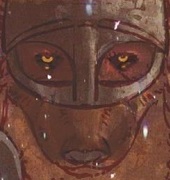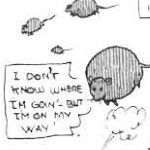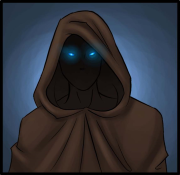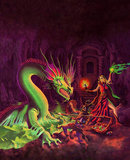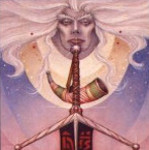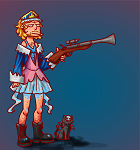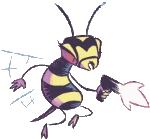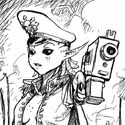|
Jerik posted:Huh. I thought the common wisdom was that having too many campaign settings was a major contributor to TSR's financial strugglesóthat having so many campaign settings split the fanbase and they didn't sell as well as they needed to to recoup the production costs. In fact, it was my understanding that Wizards of the Coast in their own analyses arrived at that conclusion and so made the conscious decision to limit the number of campaign settings they supported in later editions. Bill Slavicsek's "many buckets theory" is sheer loving nonsense. Like, a restaurant should only ever sell one menu item! If they sell anything else, they're getting into competition with themselves! It's definitely possible to diversify your product line too much, but the question of how much is too much rests on a lot of different factors. Bill also supposes that you can never do anything to increase demand for your products. It's so bizarre that I have to wonder if he was misquoted or taken out of context. The problem seems to have been that WotC did no market research and made some severe missteps in marketing outside their traditional wheelhouse. They invested in too many weird boutique products, were difficult to work with as a licensor, and did downright weird poo poo like buy a textile company. When something was successful, they immediately acted like the gravy train would never end. (The ever-expanding novels were hugely profitable until they weren't, and Dragon Dice was successful in its first year.) The thing is, Williams made major mistakes, but her critics are often people who appear to have been just as blinkered as she was. Like, Gygax wanted to fire her so he could give her job to his wife. Rob Kuntz, who left the company when Gary was forced out, flat-out admits that he holds the customer base in utter contempt. The Red Box was their biggest selling product ever, but Basic lost an internal edition war because it was "for kids" and didn't contain endless rules cruft. Strangely, I've never read an interview with a TSR veteran who condemned Williams with statements like "She should have ended the Historical Reference series when the first two didn't sell." Some of them seem to have been happy writing for an audience of themselves. As for your beloved 2e campaign settings, I also don't agree with the Gamespy article's claim that the different campaign settings were splitting and shrinking the customer base. By their own admission, the different settings appealed to different types of people! They're contradicting themselves. It's much more reasonable to assume that if someone buys Planescape and only Planescape, they were probably never going to get into Dragonlance if Planescape wasn't around. I do think that TSR eventually published too many campaign settings, but that the problem was not too much diversity but too little. Can you tell the difference between Forgotten Realms, Greyhawk, Mystara, and Birthright by looking at the cover of the sourcebook?
|
|
|
|

|
| # ? Apr 20, 2024 03:06 |
|
Mystara had a rad arcade game series, that's all I know about it.
|
|
|
|
DAD LOST MY IPOD posted:These read like NPC rules, which is a shame, because 1e Zeky had subtler rules that made them viable PCs. Like, their disquiet used to inflict Cold War style paranoia and distrust, kind of like The Monsters Are Due On Maple St. Now itís just Radiation Madness. They're not even useful NPC rules because they tell exactly one story: A Zeky has shown up and now the entire town is dead and radioactive. e: and I should note, it's very clear that whoever wrote the NPCs did not know this. I suspect the part about the radiation stuff and rules for having a Zeka around and the part about the characters were not done by the same person. Mors Rattus fucked around with this message at 21:46 on Sep 24, 2019 |
|
|
|
Wasnít the textile company buy just nepotistic fraud done before Williams or am I thinking of another inexplicable acquisition?
|
|
|
|
DAD LOST MY IPOD posted:one thing thatís always been a bit off putting to me about oWoD AND nWoD is the incredible amount of proper nouns. I know you canít run a game without naming some basic concepts, but Promethean really struck me as the apotheosis (perhaps Apotheosis?) of this runaway idea: you have a Lineage which has a dominant Humour and Element and grants you Bestowments, and a Refinement which grants you Transmutations according to Role and Alembic, all of which are fueled by Azoth, which can also cause Wastelands, Disquiet, Torment and even Firestorms. In addition to accumulating Azoth to live you try to generate Vitriol to make an Athanor. You must beware of Flux, which leads to Pandorans, separated into different Mockeries and sometimes becoming Sublimati or Praecipati... Werewolf is the worst about proper nouns, because every loving single one of them is in a foreign, made-up tongue (some have English counterparts, which the authors sometimes use). So you have to learn that Uratha are split between Urdaga (the Forsaken) and Anshega (the Pure), that when you enter kuruth you spend some time in basu-im before entering wasu-im, that Hunters in Darkness are also called Meninna and when the text mentions an Iminir, it means a Storm Lord. If you like, you can even learn each Tribe's ban in
|
|
|
|
For what it's worth, I definitely agree that nWoD started weak and picked up over time. If we think of them as new editions of the oWoD games (I know it's more complicated than that now), Changeling might be the most-improved game of all time; The Lost took a goofy, meandering, forgettable also-ran game for art class teens and transformed it into a thoughtful, humane exploration of abuse, trauma, and mental illness that captured the spirit of "faerie stories" way better than The Dreaming. Apart from some pretty lame art, the core book is one of my favorite WoD products (if not RPG books) of all time.
|
|
|
Gantolandon posted:Werewolf is the worst about proper nouns, because every loving single one of them is in a foreign, made-up tongue (some have English counterparts, which the authors sometimes use). So you have to learn that Uratha are split between Urdaga (the Forsaken) and Anshega (the Pure), that when you enter kuruth you spend some time in basu-im before entering wasu-im, that Hunters in Darkness are also called Meninna and when the text mentions an Iminir, it means a Storm Lord. If you like, you can even learn each Tribe's ban in
|
|
|
|
|
Mors Rattus posted:They're not even useful NPC rules because they tell exactly one story: A Zeky has shown up and now the entire town is dead and radioactive. I'm only lightly familiar with Promethean, but I feel like there would've been an okay ticking clock scenario in the Zeky if their rules were a more toned down extension/modification of the Extreme Environments rules. Of course in any case they need to have their escalation rate curtailed.
|
|
|
|
That Old Tree posted:I'm only lightly familiar with Promethean, but I feel like there would've been an okay ticking clock scenario in the Zeky if their rules were a more toned down extension/modification of the Extreme Environments rules. Of course in any case they need to have their escalation rate curtailed. They'd be much more usable if it took them a lot longer to get to Intensity 4-5. Intensity 1-3 are really nasty in the long term but 'causes leukemia in the longterm' and 'literally melts people by standing nearby for ten minutes' are very different.
|
|
|
|
I thought it was the mind-boggling supplement churn TSR had going on during its latter days. I remember seeing softcovers for multiple settings coming out like clockwork each month at one point, plus the 'un-branded' stuff that just seemed to be whatever mostly stuck to the wall that quarter. Edit: And whoever thought 'Radiation! That's such a fun mechanic to play with!' really needs a chatting with.
|
|
|
|
TSR hit the supplement treadmill hard, to the point that gaming magazines like InQuest regularly ragged on them for publishing generic sourcebooks full of reprinted material. Another problem was that rule-wise, every developer was going off in their own direction and they were all just stacking cruft onto AD&D2e, which didn't go nearly far enough in evolving from 1e in the first place. Like, Zeb Cook wanted to replace THAC0 with ascending to-hit and AC, but they were afraid it would make Baby cry. Reading the AD&D2e Player's Handbook depresses and angers me in equal measure. Halloween Jack fucked around with this message at 22:30 on Sep 24, 2019 |
|
|
|
I reached a point where I stopped buying Planescape and Dark Sun books because they were shrink-wrapped and I couldn't be certain they weren't just reprints of stuff I already had. I remember seeing ascending AC in a Gamma World book (4th edition?) and wondering why the gently caress they hadn't thought of doing that before. And god, there were some really awkward systems hung off the protruding bits of 2E by the end. I liked Council of Wyrms as a concept, and there are definite hints of a Feat system in its weird usage of proficiencies to unlock natural abilities, but the whole thing fell apart with the slightest amount of poking.
|
|
|
|
Halloween Jack posted:Well, that conventional wisdom comes largely from an old Gamespy article and commentary from Ryan Dancey. All that is very good to hear. (Or... read.) I wasn't being at all facetious when I wrote that I hoped the conventional wisdom about TSR's having torpedoed itself with too many campaign settings was completely wrong. I'd seen it stated enough I figured there must be something to it, but it never really sat well with me, and it's good to see a different take. Halloween Jack posted:Can you tell the difference between Forgotten Realms, Greyhawk, Mystara, and Birthright by looking at the cover of the sourcebook? Well... maybe not just by the sourcebook cover, but in content I'd argue that Birthright, at least, has enough that's unique about it to stand out from the others at least a little. But the Forgotten Realms, Greyhawk, Mystara, yeah, I'd agree they're pretty much all samey Generic Fantasy Worlds. I'd tentatively lump Dragonlance in there, too; I think its success owes mostly to the popularity of the novels, but as a campaign setting it always struck me as... completely uninteresting. (I say "tentatively", though, because I never really bothered to look into the setting in depth and don't know that much about it, so I can't rule out that there might something more interesting about it that I missed.) Yeah, when I say I liked the variety of settings TSR released for 2E, I'm referring mostly to the more distinctive and imaginative settings like Planescape, Ravenloft, Spelljammer, and Dark Sun. And yes, I definitely would have liked it if TSR had released more unusual settings like those.
|
|
|
|
Dragonlance is one of those fantasy settings where there's a strong sense, at least from reading the novels, that nothing interesting really happens where the protagonists of the novels aren't. So it's a bit "well what do other main characters do in this setting, then?" EDIT: Also the canon timeline covers so much that you'd get into fights with the novels, essentially, if you try to do anything even marginally large-scale.
|
|
|
|
Halloween Jack posted:Like, Zeb Cook wanted to replace THAC0 with ascending to-hit and AC, but they were afraid it would make Baby cry. Reading the AD&D2e Player's Handbook depresses and angers me in equal measure. Bieeanshee posted:
I vividly remember my first reading through the 3rdED PHB and having that exact same reaction. Along with replacing 'Save vs Rods/Petrificaiton and Aardvarks or whatever' with dedicated stat based saves. There is really no excuse for not having revised those by the time 2nd Ed came round. I LOL whenever I see some OSR retro-clone and they've insisted on still using THAC0.
|
|
|
Halloween Jack posted:TSR hit the supplement treadmill hard, to the point that gaming magazines like InQuest regularly ragged on them for publishing generic sourcebooks full of reprinted material.
|
|
|
|
|
Nessus posted:I think my uncle has a physical copy of one of the big collections of Every Spell They Ever Published where it is very clear that someone did a find-replace to turn "mage" into "wizard," because a lot of things deal dawizard to things. I have that too. My collection of D&D 1E and 2E materials is... by no means complete, but much closer to complete than it has any right being. There are probably much better things I could have spent all that money on. (Especially now that all those books are available cheaply in PDF form anyway, but of course I had no idea at the time that that would one day be the case.) (e: and, honestly, even if I had somehow known that, there's a good chance I would have bought the books anyway, because I'm more of a collector/hoarder than is probably healthy.) Jerik fucked around with this message at 00:55 on Sep 25, 2019 |
|
|
|
Halloween Jack posted:
I'll admit that around the time my D&D friends went all in on Forgotten Realms as our game setting and I very deliberately made all my characters native to Waterdeep because I couldn't be arsed to re-learn all the same places and histories and people TSR couldn't be arsed to make materially different from Mystara, Greyhawk, Dragonlance, and Middle Earth. Now you want a d20 fantasy world I could get behind, it's Spelljammer! Hippos! In! Space! Best D&D setting.
|
|
|
|
Nessus posted:I think my uncle has a physical copy of one of the big collections of Every Spell They Ever Published where it is very clear that someone did a find-replace to turn "mage" into "wizard," because a lot of things deal dawizard to things. This remains one of my favourite RPG goofs.
|
|
|
|
Okay, I've always had a love of Modern Fantasy/Supernatural-Horror, and I've really been enjoying these Thingy/The Somethening write ups. Also, I thoroughly enjoyed Changeling: The Lost (I got 1E back in the day.) Since folks are hip deep in nWoD/CoD, I wonder if anyone could give me an idea of which product lines/books I can look into without supporting... well... corporate entities and people that are awful. There's a lot of controversy swirling around White Wolf and Onyx Path.
|
|
|
|
If it's that much easier to make a Promethean out of a clone, I'm just imagining how an Osirian Limb Tree would look. "Yes I used to have seven arms" said Six Arms the Osirian.
|
|
|
|
Late on this but, I feel like a Promethean post achieving their goals being a regular human with maybe some memories is perfect for the whole focus of their splat to be honest rather than being some special human given the focus of an abomination just wanting to be human and not actively ruin any people around it if it stays in a given area. Kinda sucks if you're attached to a PC though.
|
|
|
|
It's a good ending for the PC. It's fine for a character's story to end with 'and they got what they most dearly desired and then lived a decent life where being near them no longer pissed people off.' God willing, they'll never have to deal with a messy soup of eighty proper nouns again, too. Definitely a step up.
|
|
|
|
ChaseSP posted:Late on this but, I feel like a Promethean post achieving their goals being a regular human with maybe some memories is perfect for the whole focus of their splat to be honest rather than being some special human given the focus of an abomination just wanting to be human and not actively ruin any people around it if it stays in a given area. Kinda sucks if you're attached to a PC though. I mean, as a player you exert a lot of control over how the Pilgrimage happens. It's an end point more definitive and defining than most of the other games (Geist has something similar, though), but it's really not going to cone out of the blue and it can be put off almost indefinitely.
|
|
|
|
Also, fun fact: once Deviant comes out you can basically play a Hybrid or warrior clone with it.
|
|
|
|
PurpleXVI posted:Dragonlance is one of those fantasy settings where there's a strong sense, at least from reading the novels, that nothing interesting really happens where the protagonists of the novels aren't. So it's a bit "well what do other main characters do in this setting, then?" Dragonlance was literally a written adaptation of a D&D campaign. Not only are there published adventures that are everything in the (at least early) books, but there's author notes talking about how specific scenes from their home game were directly put into the book (including Raistlin's voice)
|
|
|
|
Night10194 posted:It's a good ending for the PC. It's fine for a character's story to end with 'and they got what they most dearly desired and then lived a decent life where being near them no longer pissed people off.' What if they New Dawn into a Chud or a liberatarian?
|
|
|
|
Seems unlikely, since the whole point of the pilgrimage is to gain understanding of and empathy for humans.
|
|
|
|
So a Zeka centimanus can just attend a stadium event and kill thousands effortlessly? Seems like a threat big enough to attract every vaguely moral supernatural around to hunt it down.I Also are vampires and other undead affected by radiation?
|
|
|
|
Vampires and mummies probably not, since they're typically metabolically inert or even magically static. Sin-Eaters are scientifically alive, so they'd generally be hosed, though they can take a ridiculous amount of punishment as we'll see in my next review post.
|
|
|
|
By popular demand posted:Also are vampires and other undead affected by radiation? The Tormented's 2e rules don't address the undead aside from Prometheans. Saturnine Night, the 1e book which introduced the Zeky and radiation rules, extends the resistance of Azoth to other Supernatural Potency traits (Blood Potency, Primal Urge, Gnosis, etc.) The radiation source rolls against you per scene of exposure and inflicts half its successes from latent sickness, then about a week later, you start taking the other half, one point of damage a day, during which time you can't naturally heal any damage. These rules address the "core" three gamelines: vampires, werewolves, and mages. Werewolves are less invincible to radiation under this scheme, because more intense radiation sources can deal lethal or even aggravated damage, but like in 2e, radiation poisoning doesn't interfere with their natural fast healing. Vampires take the initial latent damage as damage, but instead of radiation poisoning, the other half irradiates points of Vitae. When you spend Vitae, you have to spend irradiated points before you get to touch your clean Vitae. Trying to spend them on healing or Physical Intensity just wastes them without benefit, and trying to use them to cause blood bonds or nourish ghouls doesn't work and poisons the drinker. They fuel Disciplines fine.
|
|
|
|
DalaranJ posted:Imagine how bad of a bartender you would have to be to not be able to come with an answer to "where can someone find a little adventure around here". That's not a dumb question. It's a question that thousands of bartenders doubtlessly answer every day, because that's part of their job. Unfortunately they would probably assume you were looking for a brothel...
|
|
|
|
PoontifexMacksimus posted:Unfortunately they would probably assume you were looking for a brothel... Hey it's a start. Who knows, that brothel might be menaced by a criminal syndicate and needs help. Not that I think he'd ever come up with that.
|
|
|
|
PoontifexMacksimus posted:Unfortunately they would probably assume you were looking for a brothel... Suuure, "unfortunately"...
|
|
|
|
Bieeanshee posted:I remember seeing ascending AC in a Gamma World book (4th edition?) and wondering why the gently caress they hadn't thought of doing that before. Gamma World 4e was a cleaned-up AD&D, and so was Buck Rogers, I believe. BECMI/Rules Cyclopedia was still D&D, but its rules additions managed to rise above the level of cruft. It had skills and Weapon Masteries that were also a proto-feat system, and I'll take it over AD&D any day. Halloween Jack fucked around with this message at 14:39 on Sep 25, 2019 |
|
|
|
Let's Review: Warhammer 40,000 Kill Team  Part 1: Introduction Warhammer gets brought up a lot in these threads, because its such a huge product and setting and has been around for years. 40K RPGs have been dissected pretty thoroughly in this thread too. But I don't play RPGs very much, mostly because I don't have the time to commit to a regular group weekly and also because I like trying to win. But I do play the wargames, and Kill Team is a cool game which kind of bridges the two. Kill Team is a skirmish miniatures wargame produced and released by Games Workshop, which came out last year. It's played using 40K models, and is set in the same setting of eternal and nonstop war between the fascist human genocidal Imperium, their also genocidal enemies in the assembled forces of Chaos, and the collection of xeno alien species on the side. While much of the ruleset is ported from base 40k (sometimes without necessarily thinking about it), Kill Team is about small teams of soldiers fighting small, desperate skirmishes, as opposed to the larger front battles of Warhammer 40,000. And in reducing the scope of the battles you fight, Kill Team allows you to build a way more interesting narrative. Kill Team tries to be all about playing out cool action and war movies, and reinforces it using game mechanics. I like playing Kill Team much more than Warhammer 40,000, for a few reasons. Kill Team is a much more tactical game, and is all about ducking, weaving through cover and pulling off positioning until you get into a strike, because the game mechanics encourage making heavy use of terrain. Because of the fewer models and dice rolls, it's much more swingy - a single roll can decide the game, and every phase feels like a tense firefight. And because every game feels like a tense firefight, and there are few enough models in each game that you get invested in the characters and the backstories that they create. Then there's Kill Team campaigns, where your Kill Team grows and develops through the tense firefights they create - reinforcing the unique characters they become. Kill Team really allows you to play through the idealised Games Workshop experience, in which you build, paint and game with Your Dudes. And in doing so creates a really fun game, which I'd like to explore as a mechanism for creating and encouraging a narrative through the rules in the book. I'll aim to be going through the book, and talk about the mechanics, what they're trying to evoke, and how well they succeed. And because it is fundamentally a wargame about your dudes, I'll talk about how those dudes work on the tabletop, and the balance and relative brokenness of various teams. There's been a few updates and expansions to Kill Team since release in mid July, so i'll go through those afterwards, but mostly i'll try to talk about balance and mechanics both in the context in which they were released and updated afterwards. Kill Team is definitely a ride, and while it's probably not obscure, it's a pretty interesting game.
|
|
|
|
8e Kill Team is an obviously better effort than 7e KT was (since it was basically a no effort release), but I still don't like it - and I pre-ordered the book. The charge mechanic was borked, the campaign resources don't matter (aside from "are you still in it to win, or have you been demoted to griefing"), only a few dudes can level up, there's really no gear upgrade mechanic and the team composition on launch was... questionable (hello, Imperial Guard). But it has received a billion of expansions at this point, so maybe it's a better game at this point. Shadow War: Armageddon had a terrible name and only barely more effort than 7e KT put into it (you buy a Necron team. They have no gear upgrades. Have fun), but I enjoyed my time with it a lot more. All in all, I think Battle Companies for LotR is the best of these skirmish rulesets that GW has put out for the better games. Well, that's my bitching done, let's how the FnF goes.
|
|
|
|
Night Horrors: The Tormented Part 22: Nuclear Family So, on top of all the other issues Zeky have, they also distort their own Pyros and thus have warping effects on some of their powers. They can learn all the normal Transmutations that other Prometheans can, but often develop quirks in their Distillations or even entirely unique Alembics. In all cases, these tricks grant incredible power but at a cost, whether to the user, the environment or their throng. (Mostly, it's to the environment and people around you.) In theory, this is possible with any Transmutation, but a few are called out specifically:
Zeky also have unique access to the Nuclear Alembic, rumored to have been discovered by the first Zeka ever to exist. It causes them to always know when someone approaches them with a weapon, and if it's a gun or explosive they know its range, rate of fire, amount of ammo, yield and so on. They can spend Pyros to downgrade explosion damage to Bashing or even ignore it entirely. They can render guns, explosives or similar devices inert and unusable against them, make any combustible object explode, or make someone that's hurt them recently suffer an internal explosion that damages them based on how hurt the Zeka is.  A very sad child Dawn is very sick. Her first memory is waking up in the basement of her first hospital to see her parents fleeing. They left a note: "We're so sorry, we love you very much. Stay in the hospital. Stay out of sight. You're sick." It was on a get-well-soon card. Dawn waited, but they never came back. Not for months. And so Dawn decided that her parents hadn't specified which hospital she had to stay in. She'd learned all of her first hospital's secrets, had even met another Promethean working the graveyard shift. He'd told her what she was, but had been horrified when she showed him her tricks. So Dawn found another hospital. She had learned a lot about hospitals. People went in sick and left when they got better. Despite her poking and prodding and poor imitation of what doctors did with scalpels on sleeping patients, however, she had no idea what was wrong with her. She knew she was different and had to become human, but not even other Prometheans seemed to be sick the way she was. Dawn's third hospital had a cancer ward, and she saw herself reflected in the biopsy waste. She asked, but the doctor told her that cancer had no cure. That made Dawn angry, so she made his insides sick forever. Dawn switches hospitals every week or two, hiding from the confused doctors and staff and rifling through patient charts or poking them. She's figured out that if she stays too long, folks get violent, and of course she ruined that first cancer ward. She's learned a lot more about the Pilgrimage than you might expect for a Zeka, but she's young, entirely unguided and far too potent for anyone's good, least of all her own. Sometimes, she gets very angry when a patient recovers too well and gets to go home, especially if they were a mean person. She especially hates the smiles of their parents, and her jealousy goes out of control. She makes those patients sick again, and sometimes cuts them open to see if they get sick like she is. She isn't sure why she cries every time they do. Dawn appears to be a skinny girl with greasy blonde hair and crooked teeth. She smiles widely and often, and she's full of questions. She pretends to be carefree, and knows where just about everything is in hospitals she stays at, as well as how to move around without being seen. She's also picked up a fair amount of medical knowledge from observing procedures. She can help someone get food, medicine, a safe place to stay or an escape route out, and will happily trade this help for information about Prometheans. She's jealous of anyone that has loving parents, but she tends to take her anger out on the kids. She typically dresses in a blue hospital gown, scrub pants and a dark hoodie she's sewn a number of pockets into the interior of. Dawn believes her disfigurements are what her parents meant by 'sick,' because she is full of tumors which occasionally break the surface of her skin. Her features are swollen and distorted, and her eyes glow sickly yellow. When stressed, some of her extremities leak neoplasm, pus and tumorous tissue. At one point, Dawn met a very nasty doctor in a cancer ward night shift. She could feel the revulsion he had for her, and for the first time, she felt shame. He later screamed at her and hit another patient. Dawn heard some other doctors talk about liability, and wasn't sure what that meant, so she sat herself down in the vents over the man's desk for a week. She still feels bad about that. She had no idea everyone was going to get so violent, and had no idea they'd die. She's also scared away a few other Prometheans by accident. She doesn't mean to hurt them, but when she sees them use their powers, she gets excited and tries to copy them. Typically, the appearance of her disfigurements and nuclear energies makes them run. They start rumors that she was created by the Tsar Bomba himself, the First Zeka. She wasn't - her parents were an Osiran and Ulgan who thought that using the hospital x-ray machines would let them unify their humours and thought they were ready to be parents. Neither was the case, and the radiation was far too powerful. Dawn very much wants to meet them again. In the hospitals Dawn stays at, she has generated the story of the Tumor Fairy. The younger patients have mythologized her, saying that she comes for bad kids and gives their cancer teeth so it'll eat them from the inside out. This developed after a kid pointed at her and screamed one night, and wouldn't stop screaming and tearing at her life support devices. Dawn was extremely hurt by this, and would've taken immediate vengeance if a security guard hadn't shown up. Instead, she came back the next night...and found the girl dead. Dawn hates the name 'Tumor Fairy,' and if she hears it she will run away to cry. Dawn's not a powerful Zeka at all - only Azoth 1, so she's not immediately deadly to be around. She's pretty average, but has very poor stamina. She knows a surprising amount about investigation, medicineand Prometheans, and she's good at sneaking around and lying. She has developed some potent abilities, though. Her tumorous skin serves as natural armor against bashing damage, which she can harden to protect herself further. Her tumors can deal damage to those that strike her, and she can armor herself up even more and fire bits of the tumors to damage people. She has also developed the unique ability to focus her internal radiation into other people, giving them cancerous tumors. She is also able to boost her vision, see through solid objects and see spirits and ghosts. Next time: The Radium Girl, the Demon Core
|
|
|
|
Cheeki breeki intensifies.
|
|
|
|

|
| # ? Apr 20, 2024 03:06 |
|
Catching up from a couple pages back, but what amuses me about the Mustard Mafia excerpt is how much contempt Smolensk lavishes on the idea that a PC might think to pick a pocket or cut a purse in the crowd. As if pickpockets haven't been making a living since, probably, the invention of the pocket. I ran a short XXVc campaign back in the day and still have a bunch of stuff for it. It's a great setting but the rules let it down. I was working for a while on a conversion to the old Star Wars d6 system, but I never tested it out. (Anecdote time! I never actually paid for any of the XXVc material. At that time I was working for Random House, which had a distribution deal with TSR. One of the advantages of working at a publisher is that you can get your hands on lots of free books -- everyone gets courtesy copies, and most people don't actually want most of what they get, so every floor had a book dump box where you could toss your surplus books and just take whatever you wanted. And since there apparently weren't many gamers at the company, a lot of TSR product ended up in the dump boxes. I used to sometimes come in on weekends, go floor to floor collecting TSR stuff, and then keep what I wanted and sell the rest to a game dealer for half price. And that is my corporate corruption story.)
|
|
|




